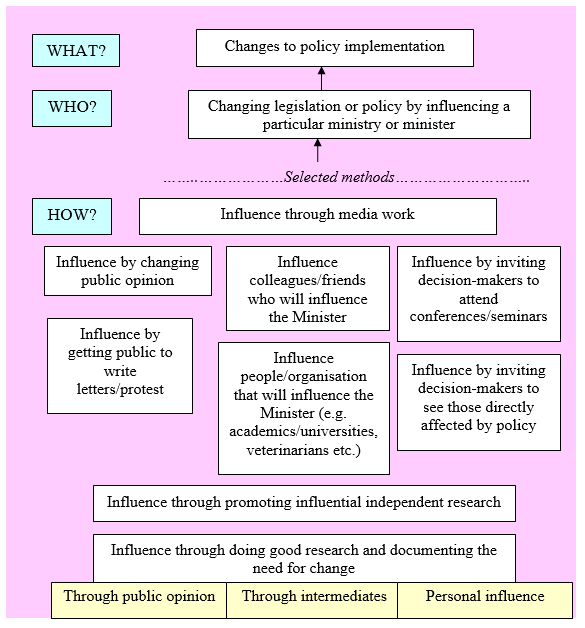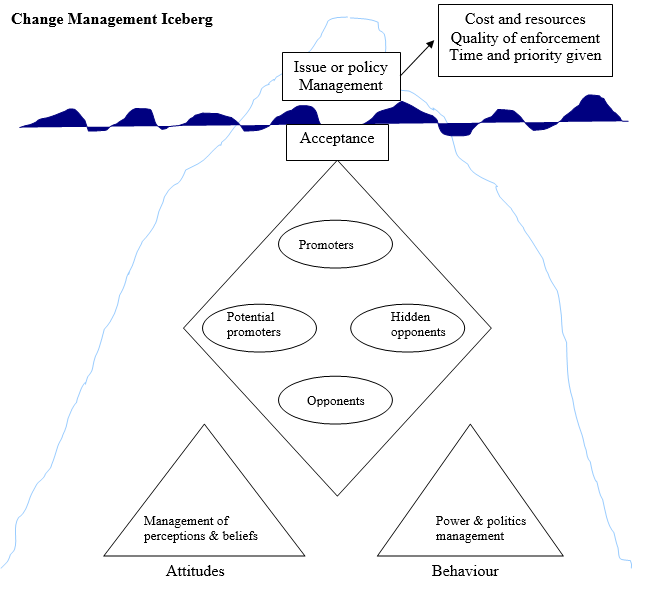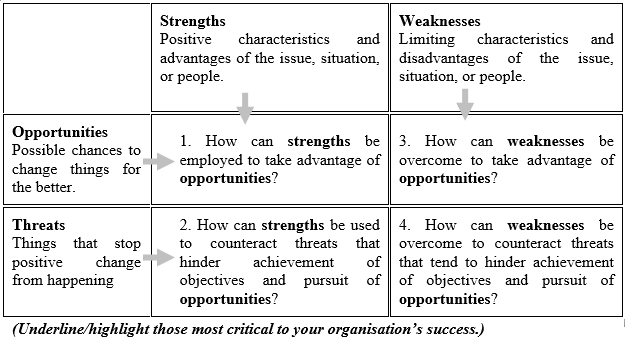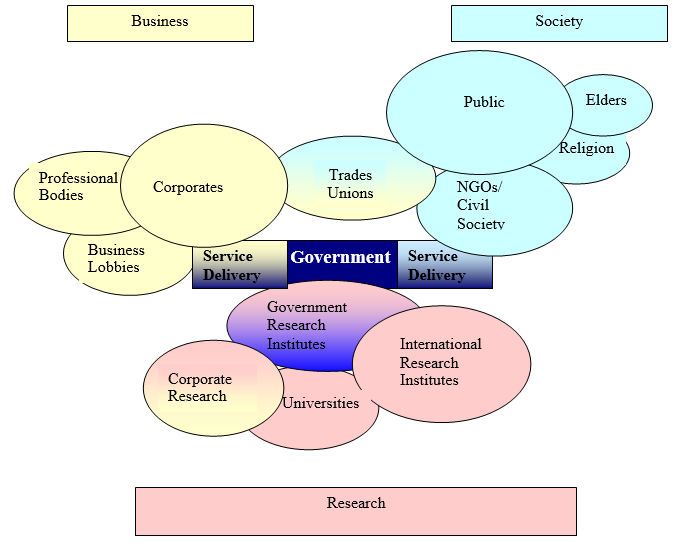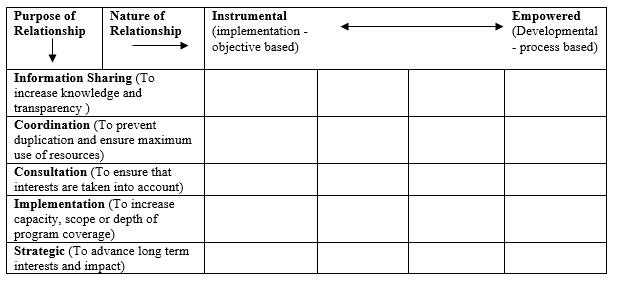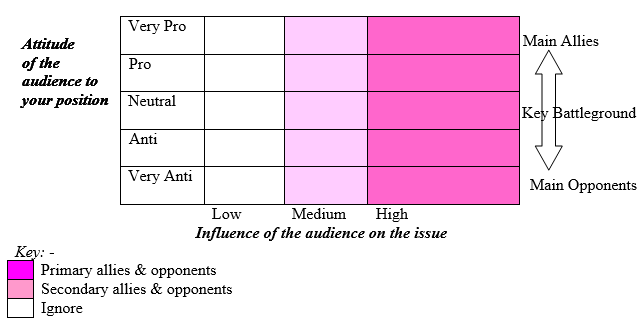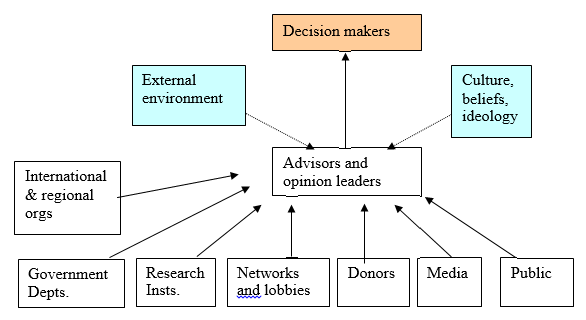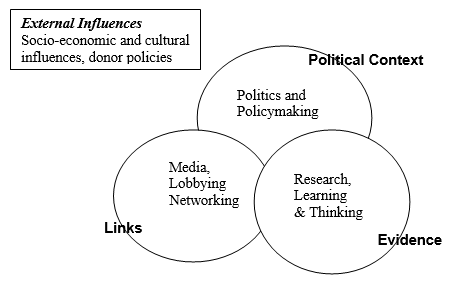
Strategic Advocacy Course (new) (123)

Category:
Recommended
Description and Purpose:
This is a diagram that examines the different pathways of influence. It can be used as a guide when determining advocacy strategies. The different methods of influence are charted as being achieved in three ways: through public opinion, intermediates, or personal contact.
Method:
Use the following model as a guide when charting your advocacy strategy.
(Adapted from: R. David, 1998, as reproduced from Chapman and Wameyo 2001)

Category:
Recommended
Description and Purpose:
The advocacy self-assessment is a tool that can be used to consider the different factors affecting your policy issue.
Method:
Use the following diagram as a guide when considering the factors – hidden and exposed – that affect the process of change.
You can use the results to decide on how to manage these throughout the change process – remembering that those ‘under the water level’ need to be managed until the change is permanent.
Opponents have a negative attitude towards change, and negative behaviour towards this particular change. They need a change of perception and beliefs, as far as possible.
Promoters have a general positive attitude towards change, and behave positively towards this change. They view it as advantageous, so will promote it.
Hidden opponents have a negative attitude towards change, but appear to support this particular change. They need a change of perception and beliefs, supported by information.
Potential promoters a general positive attitude towards change, but are not yet convinced about this particular change. Power and politics management could help to make them promoters.
Even after the change has been accepted and agreed, the forces below water level need to be managed to prevent regression.

Category:
Recommended
Description and Purpose:
The advocacy self-assessment is a tool that can be used to assist a SWOT analysis (see above).
Method:
Use the following chart to initiate the SWOT process, if there are no precise criteria already provided.
After identifying strengths and weaknesses, organizations and coalitions should try to determine ways to employ strengths to their advantage and modify weaknesses. Developing activities and institutional changes can benefit not only an organization but also the effectiveness of an advocacy campaign.
| Organizational Capabilities | Strengths | Weaknesses |
| Knowledge of the problem or issues |
||
| Understanding the aim | ||
| Understanding of the advocacy environment and context |
||
| Ability to develop the advocacy message |
||
| Ability to transmit the advocacy message |
||
| Promoting participation in the decision-making process |
||
| Quality of leadership | ||
| Diversity of membership/staff |
||
| External Relationships | Strengths | Weaknesses |
|
Ability to influence key |
||
| Ability to mobilize populations |
||
| Ability to caolition build | ||
| Ability to access media outlets |
||
| Resources | Strengths | Weaknesses |
| Human capacity | ||
| Material resources | ||
| Technological resources | ||
| Financial resources |
Adapted from the Manual for Facilitators of Advocacy Training Sessions, Washington Office on Latin America, 2001

Category:
A Primary Tool
Description and Purpose:
The SWOT analysis is a commonly used matrix tool that can provide an objective and critical self-assessment as a background to strategic planning. SWOT stands for:
- Strengths
- Weaknesses
- Opportunities
- Threats
It looks at both the external and internal factors of an organization:
- Strengths and Weaknesses are internal to the organization.
- Opportunities and Threats are external to the organization.
This tool can deal with broad or narrow issues, as long as they are clear and understandable.
Method:
Draw a matrix that has nine fields (three rows and three columns). Label the fields as Strengths, Weaknesses Opportunities and Threats as shown below.
Participants begin by listing all strengths and weaknesses in the respective fields.
Strengths: Key strengths, core competencies/capabilities or (especially) unique advantages (‘Unique Selling Points’)
Weaknesses: Weaknesses in the organization – things it does less well and/or cannot cope with
Include aspects of skills and resources (see above).
This is repeated for opportunities and threats.
Opportunities: Opportunities that may arise for the organization
Threats: Potential threats to the organization and its work (From clients, from partners/competitors, from external environment)
In some circumstances, it may be more useful to substitute Constraints for Threats (making it a SWOC analysis).
Research and/or brainstorming can be used to generate the factors. If there is a facilitator, they can encourage discussion and analysis. The four empty fields of the matrix are completed using the following questions:
Participants identify major opportunities and threats that they believe the campaign will face (agree a timescale for this e.g. over the next 1-3 years). Then, select options for action and rate them according to their feasibility and potential benefit. Discuss the results and agree actions. Copy the matrix and leave original with the group.
In identifying strengths and weaknesses, it is essential that organization’s reflections are comprehensive and honest. The more truthful an organization is, the more it stands to benefit from the assessment process. Because each organization is different, criteria to be considered in the evaluation process should be determined by the organization.
Continuous self-assessment is critical for any group or coalition involved in an advocacy campaign. By identifying and analyzing internal strengths, a group will have a greater understanding of the attributes it possesses that can be used for the benefit of the campaign. Similarly, by acknowledging and evaluating weaknesses, groups can work towards improving weak areas, or amending their strategy so these are not needed.
Another option is to use the SOAR framework:
- Strengths
- Opportunities
- Achievements
- Results
This gives a positive analysis, where actions can be built on the basis of agreed strengths, achievements and results, taking account of opportunities in the external environment. This method is in line with the ‘Appreciative Inquiry’ methodology which seeks to apply and improve tried and tested methods, without demotivating.

Category:
A Primary Tool
Description and Purpose:
The PESTLE analysis is a commonly used tool that sorts and analyses key factors from the external environmental that could impact upon the advocacy campaign. PESTLE stands for:
- Political
- Economic
- Sociological
- Technological
- Legal
- Environmental
The simpler PEST (political, economic, social and technological) is also used, but PESTLE is more appropriate to the advocacy environment.
Method:
List the environmental factors that could affect your advocacy campaign using the following categories. This can be done by brainstorming or other idea generating techniques. It can also be preceded by more thorough research into the external environment of your advocacy issue.
Political:
List the relevant political factors and trends in the country (including the government, legislature, judiciary and other government bodies, as well as other political movements and pressure groups). See Module 1: Research & Analysis.
Economic:
List the economic factors and trends in the country (including GNP, debt schedules, sources of government income, main private sector employers, income distribution, etc.).
Sociological:
List the relevant sociological factors and trends in the country (including demographic information, education statistics, employment rates, land ownership, media, etc.). Consider including:
- Factors contributing to animal welfare problems
- The overall situation in the country as regards animal welfare
Technological:
List the technological factors and trends in the country (including information technology infrastructure, access to telecommunications and broadcast media, etc.).
Legal:
List the legal factors and constraints that are relevant to your advocacy work.
Environmental:
List the relevant environmental factors and trends in the country (including habitat destruction, weather patterns, resource availability, wildlife, agriculture, etc.)
When completing this analysis, carefully consider various driving forces in the environment, for example, increasing competition, changing demographics, etc..
Having listed all the factors, you should then identify which of these may be significant to your work – either as opportunities or threats. You should then take account of these factors in your planning, and possibly do more research on the factors.
From these factors, identify five key trends that you consider most important for your issue. You can do this by ranking and sorting, voting, or by discussion and agreement. Bring these five into your strategic analysis, particularly into analysis of ‘critical issues’ at the beginning of the ‘strategic choice’ stage.
Do not forget the following:
The success of an advocacy campaign can be greatly influenced by the external environment. Each advocacy environment is different and always changing. Therefore, environmental monitoring needs to be an iterative process. Each environmental analysis should be individually tailored to suit the organization and its selected issue. However, here are some general factors that it might be useful to consider:
Political Openness
Advocacy campaigns, particularly campaigns focused on changing policy, are more likely to be effective in effective in more participatory and democratic political systems. Conversely, the more authoritarian a system is, the less likely it is that the government will respond to the issues put forward by an advocacy group. Access to key decision-makers in authoritarian political systems is also likely to be limited. This makes it difficult to advance campaign aims without a clever and appropriate strategy.
The Media
Media is an important advocacy tool to influence change. A vibrant and open public media, with freedom of speech, can play a significant role in generating public awareness and mobilizing citizens. When the media is controlled, the message and delivery of an advocacy campaign is limited. A censored media cannot easily expose activities or policies that contribute to disadvantage.
Cultural and Social Constructs
Some cultures and social groups are more tolerant of, and sympathetic to, advocacy campaigns and tactics than others. It is important to understand the cultural and social environment of a campaign. For example, in some cultures confronting decision-makers may be considered socially and politically unacceptable and such tactics may jeopardize the campaign.
Timing and Current Events
The success or failure of an advocacy campaign or strategy may depend on the timing of the implementation. It is important to be aware of certain opportune or inappropriate moments before engaging in advocacy activities. A clash with an unconnected high-profile event can lead to loss of media attention. On the other hand, some events, such as elections, international policy meetings or high-level conferences may provide a fitting occasion to highlight certain issues in an advocacy campaign.

Category:
Optional (but make sure to use some creative techniques. If just one is used, this one is suggested)
Description and Purpose:
This is a tool that encourages intuitive and creative thinking about the improvement of a current situation. The subsequent comparison of drawings enables participants to share their views of the present situation, and future possibilities, bringing forth shared visions and perceptions in the process. It can be used to gauge individual perception of a situation, or to develop a group analysis. It is a particularly useful tool in cultures with a strong visual tradition.
Method:
Introduce the idea to the group. Explain that the main purpose is not to produce a work of art, but to bring out ideas for discussion. If they cannot draw, they can use symbols or stick men!
There can be soft music playing in the background (music assists creativity and can help remove self-consciousness).
First, ask participants to draw (or depict!) the current situation on their issue. They can do whatever they like – there are no rules, and no prescription.
Let the group dynamics evolve. Often it is a simple matter of giving everyone a drawing implement and the opportunity to use it. Expect people to have reservations about their abilities, and encourage them to have a go.
Next, ask participants to draw their desired future situation (for the same issue).
When the drawings have been completed, gather participants around the drawings and ask the originator to explain each drawing. What was he depicting? Did they discover things they had not thought about before?
After examining individual drawings, compare these for similarities. Discuss similarities, and ask about marked differences. The placement and size of objects in the picture often indicates the relative importance of issues.
The interpretations of the group should be recorded for future reference.
Now discuss the difficulty of getting from the current position to the desired future situation(s). Do the drawings give any suggestions for a staged approach towards the ideal?
Benefits
- Drawings allow people to overcome barriers of social hierarchy or language. They give a voice to the less articulate, and often express opinions and feelings quickly and more clearly than speech.
- People can see and jointly develop an analysis. It deepens group identity.
- Expenses are relatively minimal, and if good materials are used, the ‘outcomes’ can be used at a later date for comparisons.
- Wide range of potential applications from individual to communal work. It can be used for comparative analysis with drawings from participatory baselines compared to drawings from evaluations.
- It builds a positive vision for participants to move towards, rather than a negative problem-solving approach (or moving away from something undesirable).
Variation
- Drawings may be produced jointly by an organization, or by individuals, and discussions focus around them.
- It can be useful to conduct this exercise with separate groups such as staff, board, animal welfare professionals etc. and then compare drawings in larger group meetings.
- Ask each member of the group to draw their picture of the desired future, and then use these to contribute to a larger, group produced picture.
- You can also ask members to divide a page into six boxes, to number these 1-6, and to draw the existing situation in box 1, the desired situation in box 6, and to draw the stages in between in boxes 2-5. This helps to demonstrate a step-wise approach towards the desired solution.
- Be creative. Instead of drawings, try mosaics, symbols, collages, sculptures, ‘museum exhibits’.

Category:
Recommended
Description and Purpose:
Force field analysis is a management tool developed by social scientist Kurt Lewin for diagnosing situations. It is also an excellent tool to use in assessing the driving and restraining forces of an advocacy issue. This is necessary in order to target advocacy resources to best effect.
Method:
Describe the current situation (the issue you wish to change).
Describe the desired situation (the policy change you are seeking through your advocacy work).
List all major forces driving change
List all major forces restraining change
Discuss and interrogate all of the forces. Are they valid? What are the critical ones?
Assign a score to each force, from 1 (weak) to 5 (strong)
Draw a diagram showing the forces for and against change (see example below). Show the size of each force as a number next to it (1=weak up to 5=strong) - or indicate relative strengths using different size arrows.
Determine whether change is viable and likely to be sustainable
Discuss how change can be made (by strengthening driving forces and weakening restraining forces)
Given limited resources, which forces should be priority targets?
Bear in mind that as each force changes, it may trigger a reaction from other forces. In particular, fighting against restraining forces (instead of strengthening driving forces or weakening restraining forces) may promote counter-attack.
You need to consider how you will change the balance of forces for and against the campaign issue in order to overcome obstacles. By carrying out the analysis you can plan to strengthen the forces supporting a change, and reduce the impact of opposition to it.
Driving forces are those factors pushing the situation forward, whereas restraining forces are the factors that stop or hamper its progress. From this, you can map potential allies and opponents. Then, from that, you can work out who your target audience is for each step of the advocacy campaign.
See below for example:
Force Field Analysis
Existing situation = government inactive on animal welfare
Desired situation = government actively working on animal welfare, with law which is enforced
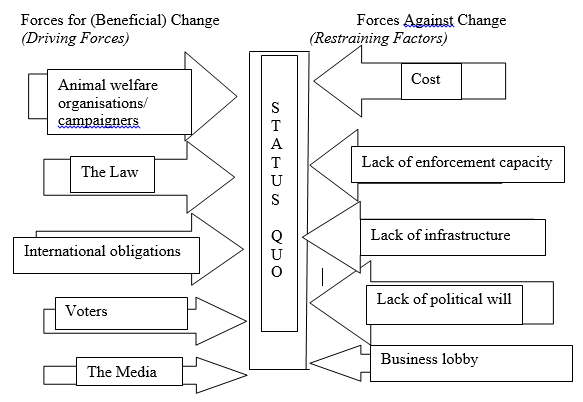

Category:
Optional
Description and Purpose:
This is a stakeholder mapping tool that shows the key organizations and individuals involved in an advocacy issue, together with their relationships. Also knows as a Chapatti Diagram.
Method:
First ask the group to identify key organizations and individuals involved in the advocacy issue. Record these on a list.
Then draw or cut out a circle (or other shape) for each organization or individual. Bigger circles indicate more important stakeholders.
The circles are labelled.
If your issue is centered on government policy, then you can make government a central block of the diagram (e.g. represented by a different shape, color or block).
Next, the group identifies the degree of contact and overlap between each circle. Overlap occurs if one individual or institution asks or tells another to do something or if they have to cooperate in some way. Arrange as follows:
- Separate circles = no contact (or no meaningful contact)
- Touching circles = limited contact (e.g. information passes between institutions)
- Small overlap = some co-operation in decision making
- Large overlap = considerable co-operation in decision making
Draw the diagram first in pencil (or on a computer) and adjust the size or arrangement of circles until the representation is accurate. Alternatively, use lengths of string – these can be expanded or contracted until the right size is agreed. A reproduction of the string/paper/pencil circles ensures a permanent record. Secondary sources, group interviews or key informants can be used to validate information.
When you write up, you can add color-coding to indicate allegiances or categories.
The process of forming a diagram gives rise to useful observations and discussions.
A simple example follows:
The example given in this tool helps to provide important contextual information, such as the way in which research underpins decision-making (which is an area in which civil society can be weak – especially the funding of original research). Also, the link between service delivery and advocacy (where the close contact can help with ongoing advocacy, but also brings its own restraints in terms of adversarial advocacy – for fear of losing contracts and jobs).

Category:
A Primary Tool
Description and Purpose:
This tool is a matrix that can be used to consider other organizations working in your field, and the nature of your relationship with them on your advocacy issue.
Method:
Map each of the important organizations working in your field in the grid.
Use this as a starting point to assess how and what they are doing.
Consider and categorize the nature of your current relationship with them.
Then, make informed choices about the type of relationship you should develop with them in the future.
As well as helping you to understand the other ‘players’ in the field, this should help you to consider how to avoid duplication, and to fill gaps in the ‘market’. In particular, which organizations you should try to prioritize for further development.
You may consider including:
- Other major animal welfare players (competitors/collaborators, national/international)
- The positioning of your organization in the wider movement.
- Whether you should adopt a competitive or collaboration strategy?
- Different forms of co-operation (e.g. joint projects, networks, coalitions and affiliations etc.)
- How full is the ‘market’ (will you be duplicating the work of others, of is there a real need for your advocacy)?

Category:
Recommended
Description and Purpose:
This tool is a matrix that can be used to categorize the allies and opponents of your advocacy issue. It helps to identify your main allies and opponents, and those whose neutral position make them targets.
Method:
Consider and categorize the allies and opponents of your advocacy issue using the following matrix. Write the name of the individual or name of the organization on a post it note and plot them on the chart according to your perception of their attitude towards and influence over the issue you intend to advocate on.
Opponents: Individuals or organizations who may oppose the advocacy campaign because they may be impacted negatively by the changes advocated, because of disagreement about underlying values or merely because they may lose face.
Allies: Beneficiaries, individuals or organizations who will directly benefit or who can be persuaded to support your advocacy effort because of sympathetic concerns and similar values.
Targets: Individuals or organizations that have the power to effect the policy change or change in implementation of a policy or practice that is outlined in your advocacy objective.
Use this sorting process as a vehicle for discussion. It is very possible that some individuals within the same organization may be allies and others may be neutral or opponents, and that their position may change over time (perhaps as a result of your advocacy!)You can use the matrix to discuss whether the assessment of main allies, targets, and opponents and neutral players is correct, and move your post it notes around accordingly. There may be factors that influence this analysis (e.g. reasons behind neutrality that would make it a waste of effort to try to influence).
Keep for consideration in the strategic planning process.
From the matrix, you can identify which of the following five influencing strategies may be most appropriate:
- Build alliances (with allies)
- Persuading the stakeholder that the issue is important (mainly for allies with high influence but low interest)
- Persuading the stakeholder that your position is right (mainly for influential neutrals, targets and soft opponents)
- Helping to increase the influence of the stakeholder (mainly for allies with low influence)
- Reducing the influence of the stakeholder (mainly for opponents with high influence)
You will need to prioritize the stakeholder groups you can target, and plan strategically according to available human and financial resources.
More...

Category:
Recommended
Description and Purpose:
This tool helps to map and analyze decision-makers and their sources of influence. Influence Mapping builds naturally on Stakeholder Analysis (and, to a degree, has similarities with the drivers or influences identified in a Force Field Analysis).
Method:
Construct and influence map or pyramid.
To do this, you need to be clear about the policy issue or change being analyzed and single out those in high positions of power. Then, differentiate between the decision-makers who have the actual responsibility to make the decisions in a specific policy area, and their opinion-leaders who can influence them or lead their opinion, and who are generally more accessible.
Every policy-maker depends on a group of advisors or specialists without whom they cannot operate. They are also accountable to, a wide group of interest groups, constituencies and lobbies. Further, they may be influenced by the nature of the information and research they receive, how it is reported in the media, the political regime, not to mention their own beliefs and ideologies. It is often helpful to map the information as a pyramid of actors and influences.
You can separate actors and other (more general) influences (e.g. by color coding or different arrows).
Discuss this as it is under construction. Which actors or influences would be difficult to convince on your issue, and why? Which may be easier to approach, and could be effective influences? Bring out interesting and new angles and approaches – for example, by linking your issue with their priority concerns.
You could try brainstorming the key individuals and institutions that carry the influence (e.g. specific people, newspapers, veterinarians, animal behaviorists, farmers etc.). This allows the group to analyze possible influence channels.
Once key channels have been identified the group should analyze their position on the topic, their key motives and their accessibility. Are they a supporter, an ally or uncommitted? Sometimes they can have a different status on different issues. What are their interests and motives for a particular position on the issue? What is their agenda, either stated or implicit? What drives them to take this position, and what constraints do they face that might make it difficult for them to move from this position. This may be ideological or personal, or it could be cultural or social. It might be financial (e.g. for monetary gain) or it may be political, based on the views of their interest groups, supporters, patrons and voters, the constituents who give them their position of power. Finally assesses how easy it will be to gain access and present the evidence or case.
See below for an example:
You may also find it useful to research and complete the following information for each of the major institutions, organizations of agencies involved.
| Main institutions, organizations, or agencies | Most important decision-makers | Their beliefs on issue | Their interests and agendas | Major sources of influence | Scope for positive influence on this issue? | Resources |
Adapt the criteria to suit your own purposes, if necessary.
If you add contact details, you can then keep this as a permanent record (and update as new information is received).
It can also be used as a strategic planning or activity planning tool.

Category:
Recommended (depending on need)
Description and Purpose:
The below ‘context, evidence, links’ model was designed as a theoretical model to highlight to researchers the different factors that are important in the policy process. However, it also lends itself well to a project planning framework, and has been adapted for this purpose in the grid below: ‘How to influence policy and practice’.
Method:
The below model has been adapted to provide easy-to-follow guidance in the grid below it.
How to Influence Policy and Practice:
| What researchers need to know | What researchers need to do | How to do it |
Political Context:
|
|
|
Evidence:
|
|
|
Links:
|
|
|
Adapted from Tools for Policy Impact: A Handbook for Researchers Overseas Development Institute (ODI)

Category:
Recommended (but feel free to adapt content to suit your purposes)
Description and Purpose:
Case studies can be prepared as part of advocacy research. Their purpose is to provide true stories to demonstrate the impact of a problem and provide information to assist analysis. They should be compiled in a systematic way in order to be credible and useful.
Method:
Investigations
Undercover investigations can be used, following research, to capture the actual situation visually. This is often useful if the authorities are in denial about the facts, or do not want the media and public to see and understand the extent of the problems.
Focus Group Discussions
Discuss animal welfare problems in relevant focus groups (e.g. farmers, producers, animal behaviorists, veterinarians etc.). A range of views, knowledge and perceptions can be gained, which improves understanding.
Individual Case Studies
Whilst background information can be collected in advance, individual case studies can be carried out by observing individual animals in certain situations, and recording details meticulously (both photographically and by written and timed observations.
Situational Case Studies
Certain situations can also be examined and researched meticulously. For example, stray control problems can be examined using area maps (sectioned), population counts/demographics, male/female ratios, birth and health records, welfare problems etc.
Benefits
Case studies are useful background for strategic advocacy planning, as they help you to understand the actual situation you are dealing with. Case studies encourage integrated thinking and awareness of the complexities of real life situations. They can help to encourage focused discussions about the problem and potential solutions. Visual evidence is a useful focus for advocacy work, and can be invaluable in raising media attention. They can also help with public awareness and education, as actual stories make more impact than cold facts.

1. Issue Choice Matrix
2. Causal Mapping or Problem Tree Analysis
3. Research Case Studies
4. The ‘Context, Evidence, Links’ Policy Framework
5. Decision and Influence Mapping
6. Allies and Opponents Matrix
7. Other Player Analysis
8. Power Mapping - Venn Diagram
9. Force Field Analysis
10. Creative Drawing
11. PESTLE – External Analysis
12. SWOT Analysis
13. Advocacy Self Assessment
14. Change Management Iceberg
15. Pathways of Influence
16. Strategies to Counter Power Blocks
17. Stakeholder Analysis
18. Johari’s Window
19. Audience Prioritization Matrix
20. Involvement of Grassroots Groups
21. Systems Mapping of Targets
22. Audience Analysis
23. Risk Analysis
24. The Bridge
25. Approaches for Effective Policy Engagement
26. Six Thinking Hats
27. Log Frame
28. Managing Coalitions
29. Effective Meetings
30. Successful Media Coverage
31. Writing a Press Release
32. ‘Letters to Editors’ & Opinion Articles
33. Media Interviews
34. Gantt Charts
35. Critical Path Analysis and PERT
36. Campaign Tactics
37. Top Tips for Lobbying
38. Communication Tips for Public Speaking or Negotiating
39. Making Presentations
40. Negotiation Technique Tips
41. Advocacy Outcomes & Achievements
42. Advocacy Evaluation Case Study
43. Tips for Evaluating Advocacy

